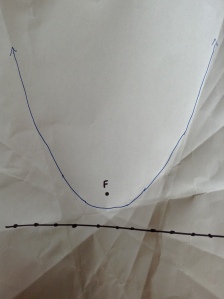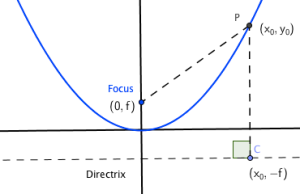Toward the end of last week, I read a description a variation on a paper-folding strategy to create parabolas. Paraphrased, it said:
- On a piece of wax paper, use a pen to draw a line near one edge. (I used a Sharpie on regular copy paper and got enough ink bleed that I’m convinced any standard copy or notebook paper will do. I don’t think the expense of wax paper is required!)
- All along the line, place additional dots 0.5 to 1 inch apart.
- Finally, draw a point F between 0.5 and 2 inches from the line roughly along the midline of the paper toward the center of the paper.
- Fold the paper over so one of the dots on line is on tope of point F. Crease the paper along the fold and open the paper back up.
- Repeat step 4 for every dot you drew in step 2.
- All of the creases from steps 4 & 5 outline a curve. Trace that curve to see a parabola.
I’d seen and done this before, I had too passively trusted that the procedure must have been true just because the resulting curve “looked like a parabola.” I read the proof some time ago, but I consumed it too quickly and didn’t remember it when I was read the above procedure. I shamefully admitted to myself that I was doing exactly what we insist our students NEVER do–blindly accepting a “truth” based on its appearance. So I spent part of that afternoon thinking about how to understand completely what was going on here.
What follows is the chronological redevelopment of my chain of reasoning for this activity, hopefully showing others that the prettiest explanations rarely occur without effort, time, and refinement. At the end of this post, I offer what I think is an even smoother version of the activity, freed from some of what I consider overly structured instructions above.
CONIC DEFINITION AND WHAT WASN’T OBVIOUS TO ME
A parabola is the locus of points equidistant from a given point (focus) and line (directrix).
What makes the parabola interesting, in my opinion, is the interplay between the distance from a line (always perpendicular to some point C on the directrix) and the focus point (theoretically could point in any direction like a radius from a circle center).
What initially bothered me about the paper folding approach last week was that it focused entirely on perpendicular bisectors of the Focus-to-C segment (using the image above). It was not immediately obvious to me at all that perpendicular bisectors of the Focus-to-C segment were 100% logically equivalent to the parabola’s definition.
SIMILARITY ADVANTAGES AND PEDAGOGY
I think I had two major advantages approaching this.
- I knew without a doubt that all parabolas are similar (there is a one-to-one mapping between every single point on any parabola and every single point on any other parabola), so I didn’t need to prove lots of cases. Instead, I focused on the simplest version of a parabola (from my perspective), knowing that whatever I proved from that example was true for all parabolas.
- I am quite comfortable with my algebra, geometry, and technology skills. Being able to wield a wide range of powerful exploration tools means I’m rarely intimidated by problems–even those I don’t initially understand. I have the patience to persevere through lots of data and explorations until I find patterns and eventually solutions.
I love to understand ideas from multiple perspectives, so I rarely quit with my initial solution. Perseverance helps me re-phrase ideas and exploring them from alternative perspectives until I find prettier ways of understanding.
In my opinion, it is precisely this willingness to play, persevere, and explore that formalized education is broadly failing to instill in students and teachers. “What if?” is the most brilliant question, and the one we sadly forget to ask often enough.
ALGEBRAIC PROOF
While I’m comfortable handling math in almost any representation, my mind most often jumps to algebraic perspectives first. My first inclination was a coordinate proof.
PROOF 1: As all parabolas are similar, it was enough to use a single, upward facing parabola with its vertex at the origin. I placed the focus at , making the directrix the line
. If any point on the parabola was
, then a point C on the directrix was at
.
From the parabola’s definition, the distance from the focus to P was identical to the length of CP:
Squaring and combining common terms gives
But the construction above made lines (creases) on the perpendicular bisector of the focus-to-C segment. This segment has midpoint and slope
, so an equation for its perpendicular bisector is
.
Finding the point of intersection of the perpendicular bisector with the parabola involves solving a system of equations.
So the only point where the line and parabola meet is at –the very same point named by the parabola’s definition. QED
Proof 2: All of this could have been brilliantly handled on a CAS to save time and avoid the manipulations.
Notice that the y-coordinate of the final solution line is the same from above.
MORE ELEGANT GEOMETRIC PROOFS
I had a proof, but the algebra seemed more than necessary. Surely there was a cleaner approach.
In the image above, F is the focus, and I is a point on the parabola. If D is the midpoint of , can I conclude
, proving that the perpendicular bisector of
always intersects the parabola?
PROOF 3: The definition of the parabola gives , and the midpoint gives
. Because
is self-congruent,
by SSS, and corresponding parts make the supplementary
, so both must be right angles. QED
PROOF 4: Nice enough, but it still felt a little complicated. I put the problem away to have dinner with my daughters and when I came back, I was able to see the construction not as two congruent triangles, but as the single isosceles with base
. In isosceles triangles, altitudes and medians coincide, automatically making
the perpendicular bisector of
. QED
Admittedly, Proof 4 ultimately relies on the results of Proof 3, but the higher-level isosceles connection felt much more elegant. I was satisfied.
TWO DYNAMIC GEOMETRY SOFTWARE VARIATIONS
Thinking how I could prompt students along this path, I first considered a trace on the perpendicular lines from the initial procedure above (actually tangent lines to the parabola) using to trace the parabolas. A video is below, and the Geogebra file is here.
It is a lovely approach, and I particularly love the way the parabola appears as a digital form of “string art.” Still, I think it requires some additional thinking for users to believe the approach really does adhere to the parabola’s definition.
I created a second version allowing users to set the location of the focus on the positive y-axis and using a slider to determine the distances and constructs the parabola through the definition of the parabola. [In the GeoGebra worksheet (here), you can turn on the hidden circle and lines to see how I constructed it.] A video shows the symmetric points traced out as you drag the distance slider.
A SIMPLIFIED PAPER PROCEDURE
Throughout this process, I realized that the location and spacing of the initial points on the directrix was irrelevant. Creating the software versions of the problem helped me realize that if I could fold a point on the directrix to the focus, why not reverse the process and fold F to the directrix? In fact, I could fold the paper so that F touched anywhere on the directrix and it would work. So, here is the simplest version I could develop for the paper version.
- Use a straightedge and a Sharpie or thin marker to draw a line near the edge of a piece of paper.
- Place a point F roughly above the middle of the line toward the center of the paper.
- Fold the paper over so point F is on the line from step 1 and crease the paper along the fold.
- Open the paper back up and repeat step 3 several more times with F touching other parts of the step 1 line.
- All of the creases from steps 3 & 4 outline a curve. Trace that curve to see a parabola.
This procedure works because you can fold the focus onto the directrix anywhere you like and the resulting crease will be tangent to the parabola defined by the directrix and focus. By allowing the focus to “Travel along the Directrix”, you create the parabola’s locus. Quite elegant, I thought.
ADDITIONAL POSSIBLE QUESTIONS
As I was playing with the different ways to create the parabola and thinking about the interplay between the two distances in the parabola’s definition, I wondered about the potential positions of the distance segments.
- What is the shortest length of segment CP and where could it be located at that length? What is the longest length of segment CP and where could it be located at that length?
- Obviously, point C can be anywhere along the directrix. While the focus-to-P segment is theoretically free to rotate in any direction, the parabola definition makes that seem not practically possible. So, through what size angle is the focus-to-P segment practically able to rotate?
- Assuming a horizontal directrix, what is the maximum slope the focus-to-P segment can achieve?
- Can you develop a single solution to questions 2 and 3 that doesn’t require any computations or constructions?
CONCLUSIONS
I fully realize that none of this is new mathematics, but I enjoyed the walk through pure mathematics and the enjoyment of developing ever simpler and more elegant solutions to the problem. In the end, I now have a deeper and richer understanding of parabolas, and that was certainly worth the journey.










